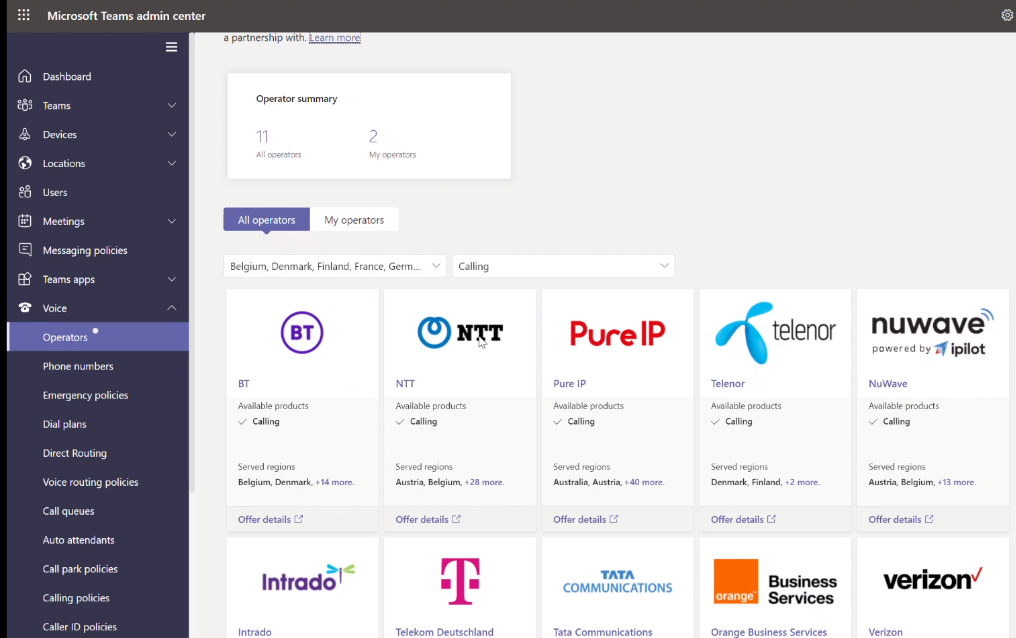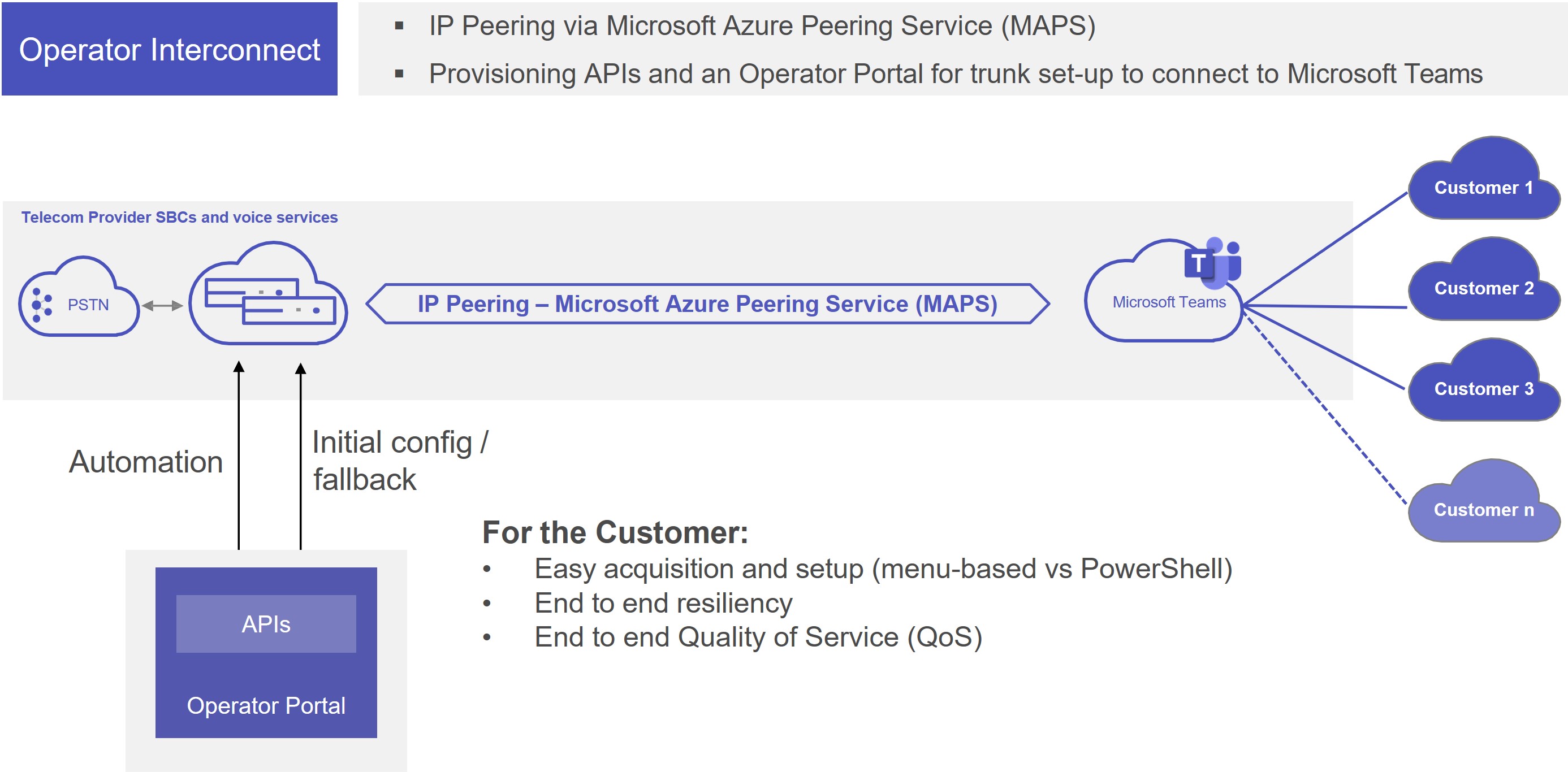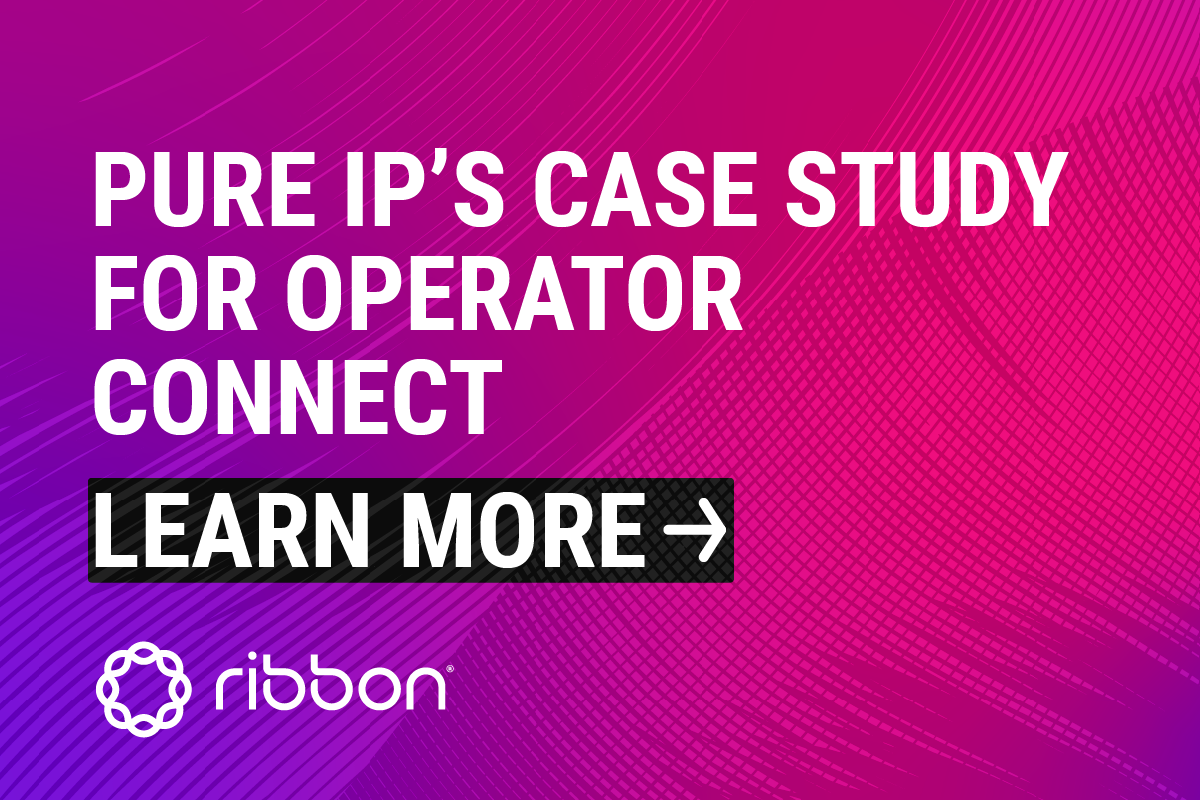What’s Driving the Interest in Microsoft Operator Connect?
In March 2021, Microsoft announced Operator Connect, a new way for organizations to connect Microsoft Teams to a telecom provider. From an enterprise buyer’s perspective, Operator Connect delivers a new “apps store” type of experience to enable organizations to choose a telecom provider and connect Teams users to the PSTN from the Teams admin center. Equally important, Operator Connect enables a new set of menu-based user configuration tools within the Teams admin center. This eliminates the need for administrators to use text-based PowerShell commands for user configuration.
Microsoft Azure Peering Service
From a service provider’s perspective, Operator Connect exclusively uses a cloud-to-cloud SIP peering model for connectivity, there is no concept of routing SIP trunks to a customer’s premises. Additionally, Microsoft has created some specific requirements around resiliency and reporting it calls MAPS (Microsoft Azure Peering Service,) which are designed to assure reliability and QoS, and will be further detailed below.
Not surprisingly, given Microsoft’s position in the market, Ribbon has received inquiries from many of its service provider customers aiming to understand how Operator Connect impacts their networks, offerings, and customers. Given our long-standing relationship with Microsoft, our staff has been aggressively working to gain an in-depth knowledge of the Operator Connect architecture and requirements. We recognize that many of our customers are using Ribbon SBCs at the core and edge of their networks to support Microsoft Teams Direct Routing deployments and as such want to be sure they can continue to leverage those investments.
Market context – what has likely driven Operator Connect’s introduction?
Microsoft Teams delivers collaboration services to over 250 million monthly active users and continues to grow rapidly. However, even with this rapid growth in users, the adoption of Microsoft Phone System (Teams’ hosted PBX service), has yet to become truly mainstream. Anecdotal data suggests that under 10% of Teams users are using Phone System for PSTN calls. Even when organizations have already purchased the appropriate Microsoft Phone System licenses (built-in to E5 licenses or as an add-on to E1/E3 licenses), only a relatively small portion have connected their users to the PSTN.
Any cloud UC service with 10 million or more users is incredibly impressive but at the same time, the current Phone System take rate points to the potential opportunity that has yet to be realized. It would not be surprising that Microsoft might look for ways to accelerate Phone System adoption and better leverage its incredible Teams user base. It seems likely that they looked at the current adoption rates and did their homework to learn what factors could be holding back adoption. From Ribbon’s perspective, the answer seems to be multi-faceted. Conversations with prospective buyers suggest the following challenges:
- Microsoft’s own calling plans are not universally available (only 33 countries).
- Calling Plans aren’t viable for businesses that have a long-term contract with a telecom provider.
- Direct Routing requires multiple vendors in the buy & deploy workflow.
- PowerShell-based configuration is challenging and unintuitive for new users.
- Cloud buyers would prefer app store-oriented acquisition and deployment experiences.
- Existing PBXs are often intertwined in business processes – need to be migrated.
- Legacy devices (fax, analog phones, elevator phones, door phones, etc.) need to be integrated into any new Teams environment.
- Many Microsoft resellers are experts at deploying Microsoft solutions but are still learning how the PSTN and PBXs work.
Ribbon believes that after considering these factors, Microsoft saw the need for a streamlined process to help Teams administrators get connected to the PSTN. Rather than make customers seek out vendors, systems integrators, and telecom providers, why not build an environment inside Microsoft 365 that makes purchasing, deploying, and managing telecom services easier? We believe that is the genesis of Operator Connect.
What’s required for providers to deploy Operator Connect?
From a SIP call control perspective, Operator Connect is nearly identical to the requirements for Microsoft’s existing SIP trunking integration, Direct Routing. If a provider is delivering Direct Routing services today, deploying Operator Connect should not require major core network enhancements. Operator Connect uses a typical SIP peering model, not significantly different from how two service providers might peer for long distance traffic. As was noted prior, Operator Connect uses an IP peering model for connectivity, SIP trunks don’t go to the customer’s premises. SIP peering to the Azure cloud uses the same SIP headers and services as Direct Routing. As such, if a provider’s core SBCs are already certified for Microsoft Direct Routing, they are also capable of supporting Operator Connect.
There will of course be some cases where providers aren’t set up for cloud-to-cloud peering with Microsoft and may need to upgrade their Session Border Controllers or other network elements, but that should be the exception rather than the rule.
Microsoft Teams Admin Center
What makes Operator Connect different is less about SIP call control and more about supporting Microsoft’s APIs so customers can interact with their telecom provider via the Teams admin center. The Teams admin center GUI is designed to make deploying Microsoft Phone System services more intuitive and more automated. This ties directly back to the key objectives of Operator Connect, making it easier for businesses to add and manage telecom services and to enable Teams Phone System.
Organizations can use the Teams admin center as a single pane of glass to:
- Select a service provider and services (potentially including their existing provider).
- Manage phone numbers.
- Assign phone numbers to Teams users.
- Provision users for Teams Phone System services.
- Report on service health and engage on support issues.
The Teams admin center enables a Teams administrator to enter their service area to find a telecom provider. The same UI provisions Teams users for Microsoft Phone System services
Microsoft created a series of APIs to enable telecom service provisioning, number allocation, quality of experience reporting, and support engagement. The Apps store model is also designed to make it easier for telecom providers to advertise and deliver high-quality services to businesses already using Teams for collaboration. Operator Connect creates a new customer acquisition strategy that would otherwise not exist. Customers simply enter their service geography, and the Teams admin Center provides potential service providers.
To take advantage of this streamlined customer acquisition and provisioning experience, service providers must be able to integrate their OSS/BSS systems with Microsoft’s APIs so that appropriate information can be exchanged for number provisioning, billing, etc. For many providers, this level of IT integration is the biggest potential challenge. Multiple legacy billing and provisioning systems may need to be integrated to deliver a clean experience for Teams admin center users. Some of the initial Operator Connect telecom providers are responding pragmatically to the challenge, taking a “crawl-walk-run" approach, integrating some processes on day 1, and rolling out enhancements over time. This strategy lets them get in market sooner.
In addition to API requirements, Operator Connect introduces important enhancements to connectivity and QoS requirements. Microsoft Azure Peering Service (MAPS) is used to assure voice quality and reliability from the Azure core to the telecom provider’s core. MAPS truly reflects a carrier-grade deployment, as providers are required to have redundant high-bandwidth links between their own network and each Azure datacenter. Microsoft defines the benefits including:
- Best public routing over the internet to Microsoft Azure Cloud Services for optimal performance and reliability.
- Ability to select a preferred ISP to connect to the Microsoft cloud.
- Traffic insights such as latency reporting and prefix monitoring.
- Optimum network hops (AS hops) from the Microsoft cloud.
- Route analytics and statistics: Events for (BGP) route anomalies (leak or hijack detection) and suboptimal routing.
|
Operator Connect adds APIs to enable a richer UX as well as a resiliency & QoS specification for interconnect. |
Depending on a provider’s existing Microsoft 365 interconnect, MAPS may require providers to make additional investments in data connectivity to the Azure cloud to support Operator Connect. On the plus side, once in place, MAPS can support Operator Connect as well as existing Direct Routing traffic, meaning existing Direct Routing customers will benefit from a more reliable and higher quality connection. Ribbon’s core SBCs can easily accommodate both deployment models. MAPS also includes reporting and serviceability tools so that providers and Microsoft can proactively manage connectivity as well as expedite issue resolution.
Comparing Operator Connect with Direct Routing
One of the most common and rational questions that comes up is, “so what’s really different between Direct Routing and Operator Connect”? As previously discussed, the call control aspects are nearly identical. The big changes with Operator Connect are related to APIs for user experience and MAPS for resiliency and QoS. In addition, Operator Connect is pure cloud interconnect, whereas the Direct Routing architecture offers the ability to integrate and migrate on-premises voice assets to Microsoft Teams.
Providers should expect that they will need to support both Operator Connect and Direct Routing for quite some time. In fact, it would not be unusual for customers to use Operator Connect for most of their PSTN traffic but still use Direct Routing for migration or integration support. Additionally, there may be customers that require Survivable Branch Appliance (SBA) services and will stay with Direct Routing until a similar capability might exist via Operator Connect. It’s very plausible that customers will deploy an edge SBC to meet analog and resiliency requirements or reuse a Microsoft Certified premises SBC that was originally deployed for Direct Routing or was supporting SIP trunks to a legacy PBX.
Below is a quick summary of the two connectivity options.
|
Services |
Operator Connect |
Direct Routing |
|
Choose a telecom provider |
Yes - customer’s choice |
Yes - customer’s choice |
|
Manage phone numbers |
Via Teams admin center (GUI) |
Customer manages via telecom provider’s call center or portal, etc. |
|
Administer Teams users |
Via Teams admin center (GUI) |
Via PowerShell (text-based) |
|
Integrate an existing PBX or UCaaS |
Not available |
Yes- via SBC and/or gateways |
|
Integrate analog (fax, etc.) |
Not available |
Yes -via SBC and/or ATAs |
|
Global coverage |
Still limited but expected to grow rapidly |
Yes |
|
Survivable Branch Appliance (SBA) Support |
No |
Yes |
Ribbon views the two Microsoft services as complementary. Since Ribbon core and edge SBCs (including hundreds of thousands of EdgeMarc devices and our Ribbon Connect services) are Microsoft certified, providers have tremendous flexibility as to how they roll out Operator Connect support. They can move aggressively or create complementary offers using Ribbon Connect for Microsoft Teams Direct Routing or do both.
Taking the next step?
Service providers often ask, “How do I get my name listed in the Teams portal?”. Unfortunately, this is not a question that can easily be answered. Operator Connect is a service offering, not a marketing program. If a provider wants to be included, they must contact Microsoft for consideration in the program and take the steps necessary to deploy Operator Connect.
Ribbon has a longstanding relationship with Microsoft and multiple service provider customers already deploying Operator Connect. We can help you get started. If you are an existing Ribbon customer, you can connect with your account team. If you are new to Ribbon or don’t know who to contact, use the Contact Us button and we will reach out.
Learn more:
Microsoft’s Operator Connect Web Page









